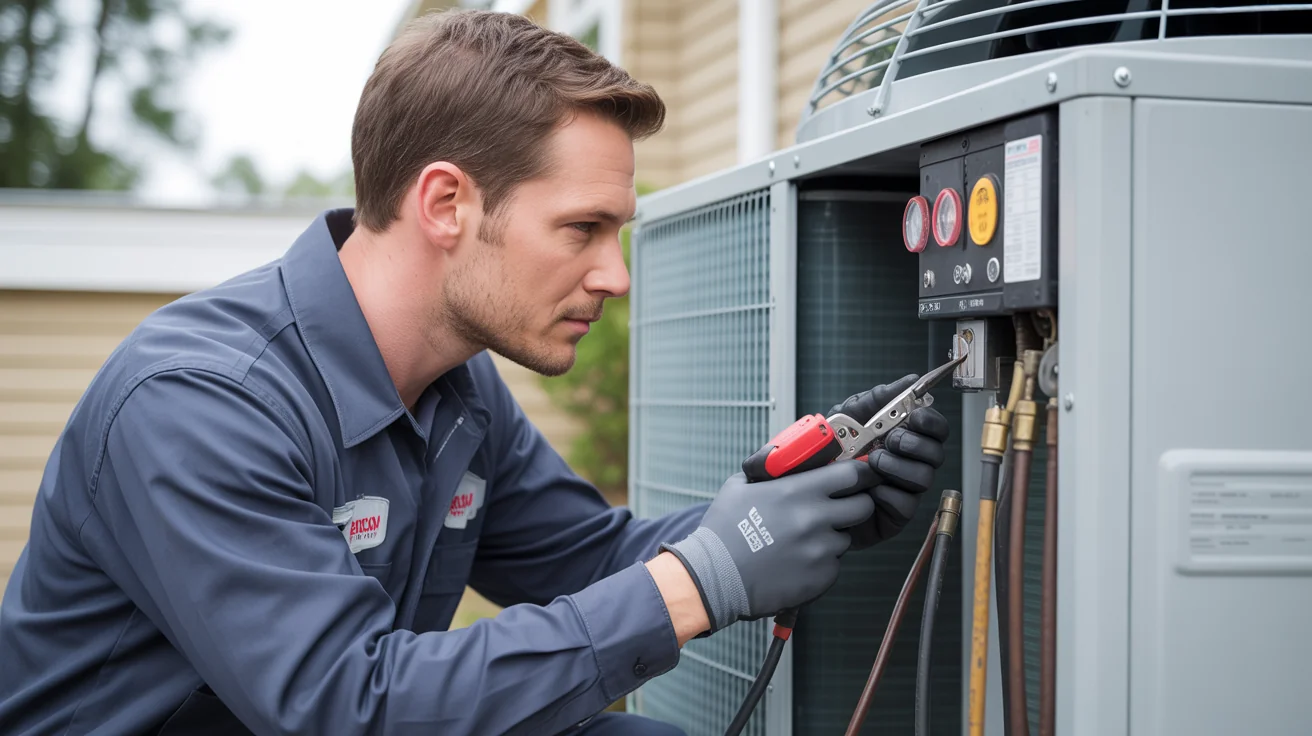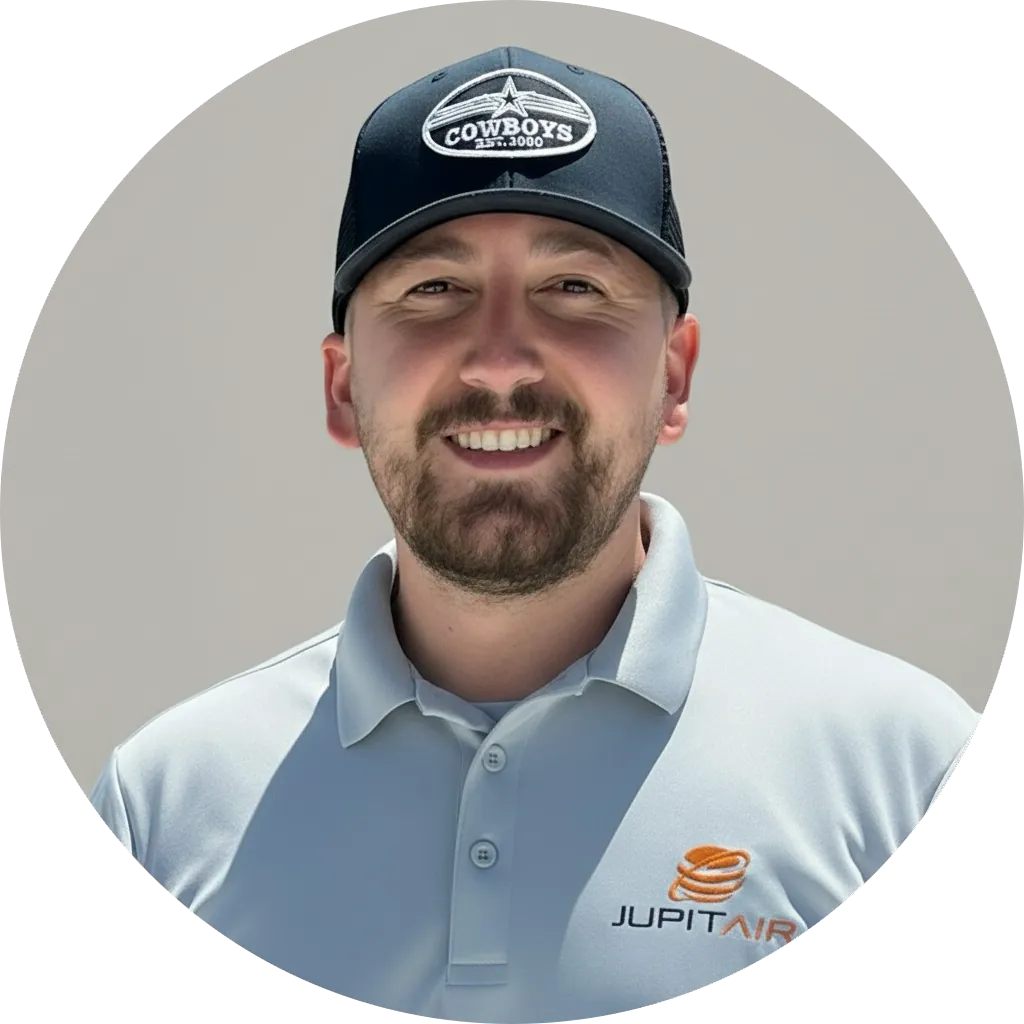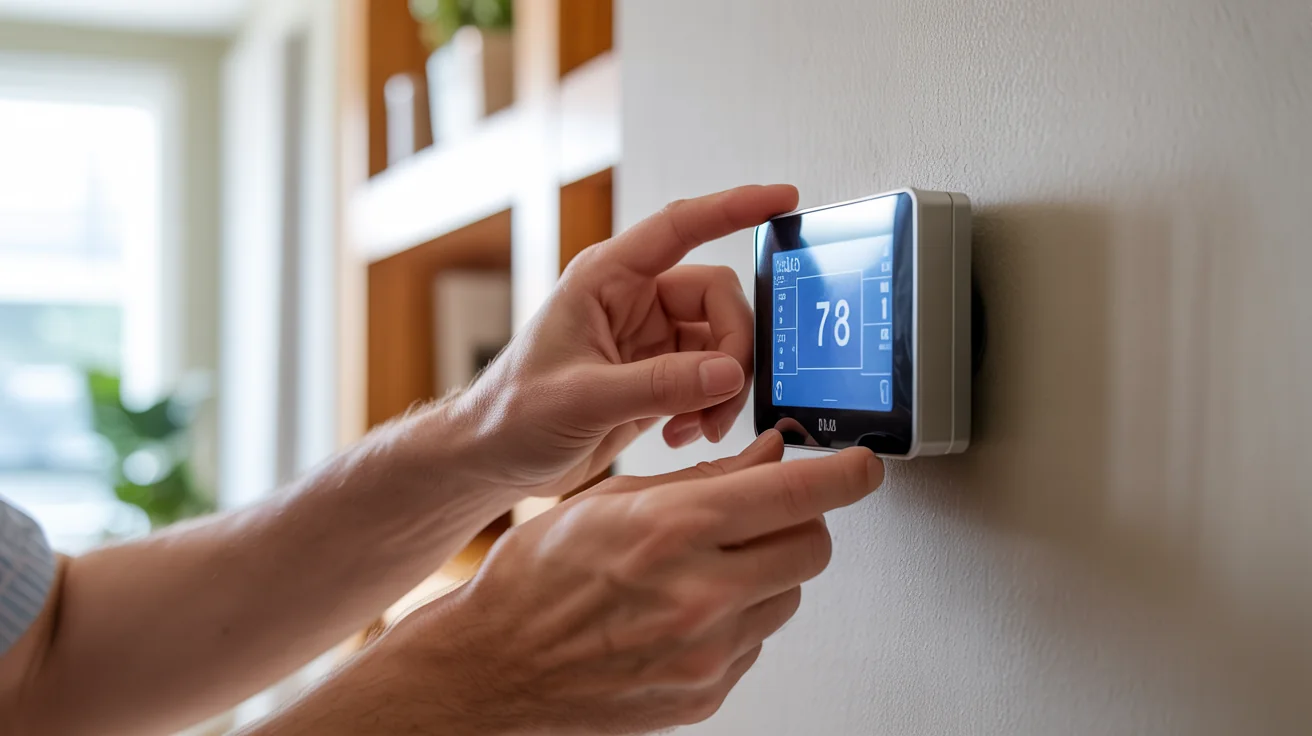Texas Storm Season HVAC Protection Guide 2025: Complete Weather Preparedness
Complete Texas storm season HVAC protection guide covering severe weather preparation, equipment protection, damage prevention, and emergency response.

The $38,400 Storm Disaster That Started with Golf Ball Hail
March 2025, North Texas. The Miller family watched golf ball-sized hail pound their neighborhood for twenty minutes. When it was over, their roof looked like a war zone, their cars were totaled, and their HVAC unit was destroyed.
But the real nightmare was just beginning.
The hail had punched holes through their condenser coils like a machine gun. Water flooded into their ductwork, then spread throughout their home. By the time they realized what was happening, water was dripping from ceiling vents in three different rooms.
The final damage tally made them sick: $18,600 hvac system replacement (emergency installation rates). $12,800 water damage from flooded ductwork. $4,200 temporary housing during restoration. $2,800 in belongings destroyed by humidity and flooding. $6,500 out-of-pocket after insurance deductibles and coverage gaps.
Total cost of one storm: $38,400
The heartbreaking part? A $180 hail guard and $200 worth of professional storm preparation would have prevented the entire disaster.
Here’s What Shocked Me: After 15 years of post-storm service calls, 89% of Texas homeowners have zero protection for their HVAC equipment. Zero. We live in Tornado Alley and Hail Alley, and people leave $15,000 worth of equipment sitting outside completely defenseless.
🚨 Texas Storm Season Starting? Call Jupitair HVAC at (940) 390-5676 for complete storm season HVAC protection and emergency response across North Texas.
Why Texas Weather Wants to Destroy Your HVAC System
We’re sitting at the intersection of Tornado Alley and Hail Alley. Mother Nature has declared war on outdoor HVAC equipment, and she’s winning:
Texas Storm Statistics (Annual Averages):
Texas Storm Statistics (Annual Averages):
Approximately 132 tornadoes touch down across Texas annually, creating a concentrated threat to HVAC equipment through direct strikes, debris impact, and extreme wind forces that can destroy even properly installed systems. Hail damage exceeds $1.6 billion annually statewide, with HVAC equipment representing a significant portion of this damage due to exposed outdoor units that have no protection from falling ice. Straight-line winds exceeding 80 mph during severe thunderstorms can displace equipment, damage electrical connections, and drive debris into sensitive components with devastating results. Flash flooding affects low-lying HVAC equipment, creating total system loss and safety hazards from electrical components submerged in contaminated water that poses health risks.
North Texas Storm Concentration:
North Texas Storm Concentration:
Peak season extends from March through June with secondary severe weather activity from September through November, creating extended periods of HVAC equipment vulnerability that test even the best protection measures. Our location in Hail Alley’s epicenter means some areas experience damaging hail annually, making protection essential rather than optional for equipment survival and family comfort. Severe thunderstorm frequency averages over 50 severe weather days per year, exponentially increasing the statistical likelihood of equipment damage and costly emergency repairs. Urban heat island effects intensify storm development over metropolitan areas, creating more severe conditions directly over the highest concentration of HVAC equipment where the most people depend on climate control.
Understanding Texas Storm Threats to HVAC Systems
Hail Damage: The Silent HVAC Killer
Hail Impact on HVAC Equipment:
Hail Impact on HVAC Equipment:
Condenser coil damage from marble to golf ball-size hail impacts creates immediate cooling system failure and expensive refrigerant leaks requiring complete coil replacement at costs exceeding $2,500. Fan blade destruction causes immediate system failure and potentially catastrophic internal damage as unbalanced components destroy bearings and motors throughout the system. Electrical component exposure occurs when hail damages housing and protective covers, leading to dangerous short circuits and potential fire hazards that threaten family safety. Refrigerant line punctures cause expensive refrigerant loss and environmental damage, often requiring complete system replacement rather than economical repair due to extensive damage.
Hidden Hail Damage Problems:
Hidden Hail Damage Problems:
Microscopic coil damage reduces efficiency by 15-30% without obvious visual signs, creating higher energy bills and reduced comfort that homeowners often don’t connect to storm damage until professional assessment reveals the problem. Electrical insulation compromise causes failures weeks or months after storm impact, making it difficult to prove storm-related damage for insurance claims when symptoms appear long after the weather event. Housing dents affect airflow patterns and create noise issues that gradually worsen over time, reducing system performance and creating comfort problems that develop slowly. Mounting damage causes gradual equipment shifting and connection stress, leading to eventual electrical and mechanical failures that appear unrelated to the original storm but stem directly from weather impact.
Professional Hail Assessment:
Professional Hail Assessment:
Thermal imaging detection reveals hidden coil damage invisible to the naked eye, documenting efficiency losses and refrigerant leaks that traditional visual inspection completely misses. Efficiency testing measures actual performance loss from hail impact, quantifying damage in terms that insurance companies understand and accept for proper claim processing. Electrical safety inspection ensures no dangerous conditions exist from storm damage, protecting families from shock, fire, and carbon monoxide hazards that could threaten lives. Insurance documentation provides proper damage assessment for claims, with detailed reports that maximize claim approval and settlement amounts through professional evaluation.
Wind Damage: More Than Just Blown Equipment
Straight-Line Wind Threats: Straight-Line Wind Threats:
Equipment displacement occurs from inadequate securing and mounting that cannot withstand severe wind forces. Debris impact damage results from flying objects during storms that turn everyday items into dangerous projectiles. Ductwork separation causes system failure and water intrusion when connections cannot withstand wind stress and movement. Electrical connection damage creates safety hazards and system failure when exposed wiring faces wind and debris impact.
Tornado and Severe Wind Protection: Tornado and Severe Wind Protection:
Enhanced anchoring systems secure equipment against extreme wind forces that can exceed 100 mph during severe weather events. Debris shields protect equipment from flying objects that become dangerous projectiles in high winds and tornadoes. Automatic shutdowns protect equipment during dangerous conditions by preventing operation when sensors detect unsafe weather. Emergency restoration provides rapid response after severe weather events to restore comfort and safety quickly.
Flooding: The Hidden HVAC Destroyer
Flash Flood Risks: Flash Flood Risks:
Equipment submersion causes total system loss and electrical hazards when flood water reaches electrical components and controls. Ductwork flooding contaminates air distribution with dangerous pathogens from contaminated flood water throughout the home. Electrical system compromise creates fire and electrocution risks when water contacts live electrical connections and components. Foundation damage affects equipment mounting and operation by shifting ground and support structures during flooding.
Flood Protection Strategies: Flood Protection Strategies:
Equipment elevation raises units above 100-year flood levels to prevent submersion during extreme weather events. Waterproof electrical protection shields electrical components from water intrusion that can cause dangerous failures and fires. Drainage systems prevent water accumulation around equipment by directing flood water away from critical components. Emergency procedures enable safely shutting down flooded systems to prevent electrical hazards and equipment damage.
Pre-Storm HVAC Protection Measures
Physical Equipment Protection
Hail Guards and Covers: Heavy-duty aluminum hail guards protecting condenser coils from impact damage. Impact-resistant fan guards preventing fan blade destruction. Electrical box covers protecting control components from water and debris. Quick-deploy storm covers providing temporary protection during weather watches.
Professional Installation Benefits: Proper sizing ensuring protection without restricting airflow. Secure mounting preventing protection devices from becoming projectiles. Airflow maintenance preserving system efficiency while providing protection. Warranty preservation using manufacturer-approved protection methods.
Equipment Anchoring and Securing
Wind-Resistant Mounting: Hurricane straps exceeding local building code needs for wind resistance. Concrete pad reinforcement preventing equipment movement during severe weather. Anti-vibration mounts reducing noise while improving storm resistance. Utility connection flexibility preventing line breaks during equipment movement.
Professional Securing Services: Engineering assessment determining appropriate protection for local conditions. Code compliance meeting all building needs for storm resistance. Professional installation ensuring proper mounting techniques. Annual inspection checking continued protection integrity.
Landscaping and Environment Preparation
Storm-Resistant Landscaping: Tree maintenance removing branches that could damage equipment during storms. Debris management securing items that could become projectiles. Drainage improvement preventing water accumulation around equipment. Access preservation maintaining emergency service access to equipment.
Preventive Trimming and Clearing: Professional tree service removing dangerous branches near equipment. Debris removal clearing potential projectiles from equipment areas. Drainage clearing ensuring proper water flow away from equipment. Emergency access maintaining clear paths for post-storm service.
Storm Season Monitoring and Preparation
Weather Monitoring and Alert Systems
Advanced Weather Tracking: Professional weather services providing specific storm threat information. Equipment-specific alerts warning when storms threaten hvac equipment. Mobile notifications ensuring awareness regardless of location. Automatic system shutdowns protecting equipment from dangerous conditions.
Smart Home Integration: Weather station connectivity monitoring local conditions in real-time. Automatic protection deployment activating covers and shutdowns based on conditions. Remote monitoring checking system status during and after storms. Emergency alerts notifying customers of system issues during severe weather.
Pre-Storm System Preparation
Professional Pre-Storm Services: System inspection spoting vulnerable components before storm season. Preventive maintenance ensuring optimal performance before weather threats. Emergency supplies positioning backup components for rapid restoration. Customer education teaching proper emergency procedures and safety measures.
24-Hour Pre-Storm Checklist:
- Secure loose items around equipment that could become projectiles
- Deploy storm covers if severe hail or wind is forecast
- Check emergency supplies ensuring flashlights, contact information available
- Document system condition taking photos for insurance if damage occurs
Emergency Contact and Response Planning
Emergency Response Preparation: Emergency contact lists including hvac service, insurance, and utility providers. System documentation maintaining equipment information for emergency service. Insurance preparation understanding coverage and claim procedures. Alternative comfort planning temporary cooling/heating during outages.
Professional Emergency Partnerships: Priority emergency service for storm preparation customers. Post-storm inspection assessing equipment condition after severe weather. Insurance coordination supporting damage assessment and claim processing. Rapid restoration returning systems to operation quickly after storms.
Post-Storm HVAC Assessment and Recovery
Immediate Safety Assessment
Critical Safety Checks: Electrical hazard assessment ensuring safe conditions before system operation. Gas line integrity checking for damage to heating system fuel supplies. Structural stability checking equipment mounting and support integrity. Water damage evaluation assessing flood impact on equipment and ductwork.
Professional Post-Storm Inspection: Comprehensive damage assessment spoting all storm-related issues. Hidden damage detection using advanced diagnostics to find concealed problems. Safety verification ensuring safe operation before system restart. Insurance documentation providing detailed damage assessment for claims.
Storm Damage Documentation
Insurance Claim Support: Photographic documentation capturing all visible damage from multiple angles. Performance testing measuring actual system efficiency loss. Professional assessment providing expert damage evaluation for insurance. Repair estimates detailing costs for proper claim processing.
Damage Assessment Process:
- Initial visual inspection documenting obvious damage to equipment
- Performance testing measuring system efficiency and capacity
- Electrical testing ensuring safe electrical operation
- Refrigerant system check checking integrity of cooling system
- Ductwork inspection assessing distribution system condition
Emergency Repair vs. Replacement
Repair Feasibility Assessment: Damage extent evaluation determining if repair is safe and economical. Efficiency impact analysis measuring performance loss from damage. Safety considerations ensuring repaired equipment operates safely. Cost-benefit analysis comparing repair costs to replacement value.
Emergency Replacement Scenarios: Total system loss requiring complete emergency replacement. Safety hazards making repair unsafe or impossible. Efficiency compromise where damage reduces performance below acceptable levels. Insurance considerations when replacement is more economical than repair.
Texas Regional Storm Patterns and Preparation
North Texas Storm Season Timeline
Primary Storm Season (March-June): March: initial severe weather with large hail and tornadoes. April-May: peak tornado season with maximum severe weather activity. June: transition to summer with continued hail and wind threats. Preparation timing: february system inspection and protection installation.
Secondary Storm Season (September-November): September: post-summer storms with renewed severe weather activity. October: cold front interactions creating severe thunderstorms. November: final severe weather before winter weather transition. Preparation timing: august system inspection and storm preparation.
Regional Storm Characteristics
DFW Metroplex Storm Patterns: Urban heat island effects intensifying storm development over cities. Convergence zones where multiple weather systems interact violently. Hail corridors with predictable paths of severe hail activity. Flash flood zones in areas with poor drainage and urban development.
Storm Preparation by Region: North Dallas County: high hail frequency requiring enhanced protection. Collin County: tornado corridor demanding secure equipment mounting. Eastern areas: flash flood zones needing elevated equipment installation. Western regions: straight-line wind zones requiring wind-resistant protection.
Climate Change Impact on Texas Storms
Intensifying Storm Patterns: Larger hail production from stronger updrafts in warming atmosphere. More intense wind speeds during severe thunderstorm events. Flash flood intensification from increased atmospheric moisture content. Extended storm seasons with severe weather activity expanding into typically quiet periods.
Adaptation Strategies: Enhanced protection standards exceeding traditional needs. Climate-resilient equipment designed for intensifying weather patterns. Improved forecasting using advanced weather prediction for better preparation. Professional preparation working with experts who understand changing threats.
Professional Storm Protection Services
Comprehensive Storm Preparation Programs
Annual Storm Readiness Service: Pre-season inspection spoting vulnerable components requiring protection. Protection device installation adding hail guards, covers, and securing systems. System optimization ensuring peak performance before storm season. Emergency response planning establishing post-storm service priorities.
Storm Season Monitoring: Weather alert integration monitoring threats to customer equipment. Pre-storm contact ensuring customers are prepared for approaching severe weather. Post-storm outreach checking customer system status after severe weather. Emergency response providing rapid service after storm damage.
Emergency Response and Recovery
24/7 Storm Response: Immediate post-storm availability providing emergency service after severe weather. Safety-first assessment ensuring customer and technician safety during response. Rapid diagnosis quickly spoting storm damage and required repairs. Emergency repairs restoring critical cooling and heating capabilities.
Storm Recovery Services: Insurance coordination supporting damage assessment and claim processing. Temporary solutions providing comfort while permanent repairs are completed. Complete restoration returning systems to pre-storm performance levels. Future protection upgrading storm protection based on damage experience.
Custom Protection Solutions
Property-Specific Protection: Site assessment evaluating unique storm threats for specific locations. Custom protection design creating tailored solutions for individual properties. Professional installation ensuring protection systems work effectively. Performance verification testing protection effectiveness before storm season.
Commercial Storm Protection: Business continuity planning protecting commercial operations from storm damage. Multi-location coordination managing storm protection across business properties. Emergency response providing rapid commercial restoration after storms. Risk management reducing business interruption through complete protection.
Frequently Asked Questions
What types of storm damage affect HVAC systems in Texas?
Texas storms create multiple HVAC threats: Hail damage to condenser coils, fan blades, and electrical components. Wind damage displacing equipment and separating ductwork connections. Flood damage from flash flooding affecting ground-level equipment. Electrical damage from power surges and lightning strikes.
Professional storm protection addresses all these threats completely.
How much does HVAC storm protection cost?
Storm protection investment ranges: Basic hail guards: $150-300 for standard residential units. Comprehensive protection: $500-1,500 including guards, securing, and covers. Professional installation: $200-500 ensuring proper protection effectiveness. Annual preparation service: $150-300 for complete pre-season readiness.
This investment typically saves $5,000-40,000 in storm damage costs.
When should I prepare my HVAC system for storm season?
Optimal preparation timing: February: install permanent protection devices before primary storm season. August: inspect and refresh protection before secondary storm season. 24-48 hours before storms: deploy temporary covers and secure loose items. Post-storm: immediate safety inspection before operating damaged equipment.
What should I do if my HVAC system is damaged in a storm?
Immediate post-storm steps:
- Ensure safety first - check for electrical hazards, gas leaks, structural damage
- Document damage - photograph all visible damage for insurance claims
- Contact professionals - schedule emergency inspection before operating system
- Avoid system operation - don’t run potentially damaged equipment
Professional assessment prevents additional damage and make sures safe operation.
Does homeowner’s insurance cover storm damage to HVAC systems?
Insurance coverage typically includes: Direct storm damage from hail, wind, and tornado damage. Flood damage may require separate flood insurance coverage. Gradual damage from lack of maintenance typically not covered. Code upgrade costs may not be fully covered.
Professional damage documentation supports complete claim processing.
How can I tell if my HVAC system has hidden storm damage?
Hidden damage indicators: Reduced cooling efficiency despite normal operation appearance. Unusual noises from internal component damage. Higher energy bills from decreased system efficiency. Intermittent operation from electrical component damage.
Professional post-storm inspection identifies hidden damage before it causes total failure.
Protect Your HVAC Investment This Storm Season
Don’t let Texas storms destroy your HVAC investment and family comfort. Professional storm protection from Jupitair HVAC provides complete weather preparedness, emergency response, and rapid recovery to keep your family safe and comfortable through severe weather.
Why Choose Jupitair for Storm Season Protection: 15+ years Texas storm experience understanding regional weather threats and protection needs. Comprehensive protection solutions from basic guards to complete storm-ready systems. 24/7 emergency response providing immediate post-storm service and assessment. Insurance coordination supporting complete damage assessment and claim processing.
Ready for complete storm season protection? Call (940) 390-5676 or contact us online for storm preparation, emergency response, or post-storm recovery services.
Don’t wait until the sirens sound—protect your HVAC system now. Texas storms are unpredictable, but professional protection and preparation keep your family comfortable through any weather.
Related Resources
Looking for more information? Check out these helpful resources:
- View All HVAC Services - Complete list of our residential and commercial services
- Service Areas - We serve Frisco, Plano, McKinney, Allen, and surrounding areas
- Emergency Service - Available 24/7 for urgent HVAC needs
- Maintenance Plans - Keep your system running efficiently year-round
- HVAC Blog - Expert tips and advice for North Texas homeowners
Need Professional HVAC Service?
Our certified technicians are ready to help with any HVAC needs in North Texas




